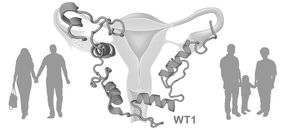Jena. For many couples, starting an own family remains an unfulfilled dream. According to estimations, this is true for about 80 million people worldwide. Some fight for years to have own children; some stay childless without any medical indication. Now, researchers from Leibniz Institute on Aging – Fritz Lipmann Institute (FLI) in Jena/Germany in collaboration with clinical partners discovered a formerly unknown gene mutation that could at least partly explain unwanted childlessness. The study’s results were recently published in the journal Human Molecular Genetics (https://doi.org/10.1093/hmg/ddx075).
Newly discovered mutation of gene WT1
In collaboration with the Sophien and Hufeland Hospital Weimar and the Heidelberg University Women’s Hospital, researchers from FLI’s research group of Christoph Englert investigated samples of women younger than 40 years that suffer from unwanted childlessness. In one out of eight women, the gene WT1 showed a previously unknown mutation in one of its two alleles. “This result was really surprising”, explains Dr. Abinaya Nathan, who is the study’s first author. “Up to now, WT1 was only known as tumor suppressor gene important for the development and maintenance of organs like heart or kidney”. But which role does this gene play with regard to fertility?
Conserved gene function
To answer this question, the researchers from Jena conducted mouse experiments. What they found was that mice lacking one Wt1 copy had far less offspring than healthy wild type mice. Moreover, the researchers discovered that it is Wt1’s activity in the ovary that regulates fertility. After ovulation, the ovary is responsible for guiding the ovule into the womb. The ovary is also the place where fertilization takes place. If the ovule was inseminated, it travels down the fallopian tube to the womb, while dividing and developing continuously. “This process has to be strictly regulated”, explains Professor Christoph Englert, who leads a research group at the FLI. “If the embryo develops too quickly, a tubal pregnancy may occur; if the embryo develops too slowly, nidation into the womb won’t be successful. Hence, the communication between mother’s ovary tissue and the ovule is a highly important prerequisite for a successful pregnancy”, continues Prof. Englert.
WT1 – Interacting with proteases
FLI’s researchers showed that so-called “proteases” are essential for this communication. They degrade proteins and “pre-digest” the embryo to prepare it for nidation. “Usually, these proteases are only active in the womb”, Professor Englert explains. “However, if the Wt1 gene is mutated, protease Prss29 already becomes active in the ovary, harming the embryo in a way that it cannot attach itself anymore to the uterine wall and finally is rejected. This could be the reason why these women cannot become pregnant even though there has been no clinical indication so far”.
“Results for mice and humans are very similar, showing that this function of the Wt1 gene is highly conserved in mammals”, Dr. Verena Holschbach from the Heidelberg University Women’s Hospital emphasizes. “The new WT1 gene mutation, which we have found, causing the premature activation of proteases already in the ovary, offers completely new approaches to help childless couples to fulfill their desire to have children”, the researchers conclude. The next steps will be even broader clinical patient screenings and a more detailed examination of how to alter the womb milieu.
Publication
Nathan A, Reinhardt P, Kruspe D, Jörß T, Groth M, Nolte H, Habenicht A, Herrmann J, Holschbach V, Toth B, Krüger M, Wang ZQ, Platzer M, Englert C. The Wilms tumor protein Wt1 contributes to female fertility by regulating oviductal proteostasis. Human Molecular Genetics 2017, DOI: 10.1093/hmg/ddx075.
Contact
Dr. Evelyn Kästner
Leibniz Institute on Aging – Fritz Lipmann Institute (FLI), Beutenbergstr. 11, D-07745 Jena
Tel.: 03641-656373, Fax: 03641-656351, E-Mail: presse@~@leibniz-fli.de









